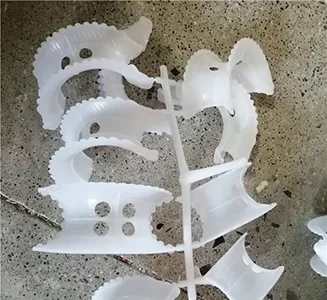Plastic Heteroclitic Saddle Ring: Product Introduction, Applications & Specification Sheet

Product Introduction
Plastic heteroclitic saddle rings are high-performance random packing materials widely used in mass transfer and separation processes across various industrial fields. Characterized by their unique asymmetric saddle-shaped design, these packing rings combine the advantages of both saddle and ring-type packings, delivering exceptional efficiency in mass transfer operations.
The structural design of plastic heteroclitic saddle rings features a curved surface with strategically placed projections and openings, which effectively breaks the directional flow of fluids. This design minimizes pressure drop while maximizing the contact area between gas and liquid phases, ensuring enhanced mass transfer efficiency. Manufactured from high-quality plastic materials such as PP (Polypropylene), PVC (Polyvinyl Chloride), PVDF (Polyvinylidene Fluoride), and PE (Polyethylene), these saddle rings exhibit excellent chemical resistance, making them suitable for corrosive and harsh operating environments.
One of the key advantages of plastic heteroclitic saddle rings is their superior corrosion resistance compared to metal packings, allowing them to perform reliably in applications involving acids, alkalis, and organic solvents. Additionally, their lightweight nature reduces the load on tower structures, simplifying installation and maintenance processes. The high void ratio of these packings ensures smooth fluid flow, preventing channeling and promoting uniform distribution of gas and liquid, which is crucial for optimizing separation efficiency.
Available in a range of plastic materials, plastic heteroclitic saddle rings can be customized to meet specific temperature, pressure, and chemical compatibility requirements, making them versatile for diverse industrial conditions.
Applications
Plastic heteroclitic saddle rings are extensively utilized in various industrial processes that require efficient mass transfer, separation, and purification. Key application areas include:
- Chemical Industry: Employed in absorption towers, stripping towers, and extraction columns for processes such as gas absorption, liquid-liquid extraction, and solvent recovery. They are ideal for handling corrosive chemicals and organic solvents.
- Environmental Protection: Used in flue gas desulfurization (FGD) systems, waste gas treatment towers, and odor control equipment to remove harmful pollutants such as sulfur dioxide, nitrogen oxides, and volatile organic compounds (VOCs).
- Water Treatment: Applied in water purification plants, wastewater treatment facilities, and ion exchange columns for processes like water softening, deionization, and the removal of contaminants from industrial and municipal wastewater.
- Pharmaceutical & Food Industry: Utilized in distillation towers, purification columns, and separation equipment for the production of pharmaceuticals, food additives, and fine chemicals, where hygiene and chemical inertness are critical.
- Petrochemical Industry: Used in gas processing, crude oil refining, and hydrocarbon separation processes to enhance the efficiency of distillation and absorption operations.
Specification Sheet
Parameter | Specification |
Material | PP (Polypropylene), PVC (Polyvinyl Chloride), PVDF (Polyvinylidene Fluoride), PE (Polyethylene) |
Size (D×H×T, mm) | 25×25×2.0, 38×38×2.5, 50×50×3.0, 76×76×4.0 (Custom sizes available) |
Specific Surface Area (m²/m³) | 150-300 (varies by size and material) |
Void Fraction (%) | 85-92 |
Packing Density (pcs/m³) | 8000-12000 (for 25mm size); 2500-4000 (for 50mm size) (varies by size) |
Bulk Density (kg/m³) | 55-85 (PP); 70-100 (PVC); 160-180 (PVDF) |
Compressive Strength (MPa) | ≥15 (PP); ≥20 (PVC); ≥25 (PVDF) |
Operating Temperature Range (°C) | -10 to 100 (PP); -5 to 60 (PVC); -20 to 150 (PVDF) |
Corrosion Resistance | Excellent resistance to acids, alkalis, and organic solvents (varies by material) |
Color | Natural (PP/PVDF), White (PVC) (Custom colors available upon request) |


.jpg)
.jpg)
.jpg)
.jpg)
.jpg)